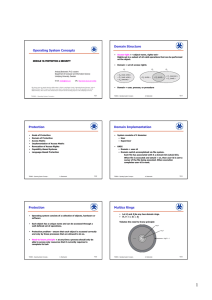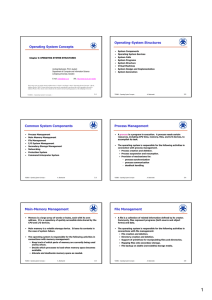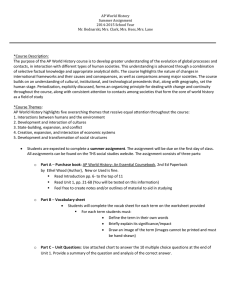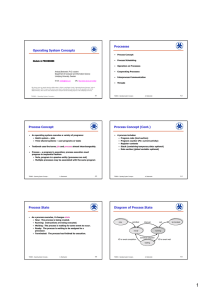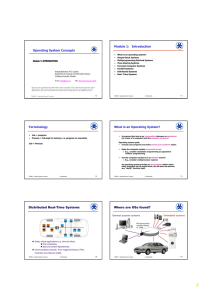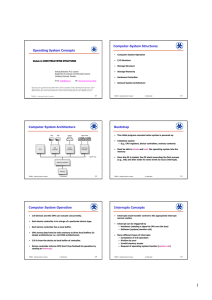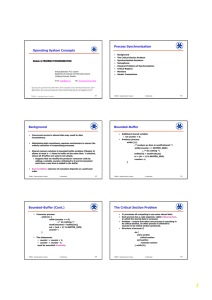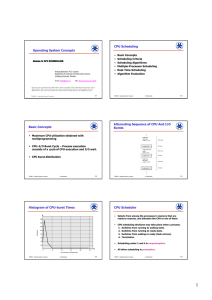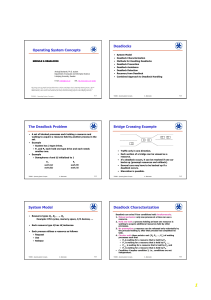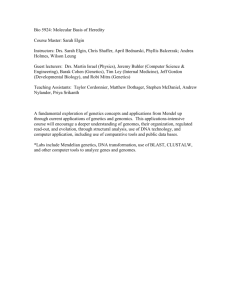Memory Management Operating Systems Concepts Background Logical versus Physical Address Space
advertisement
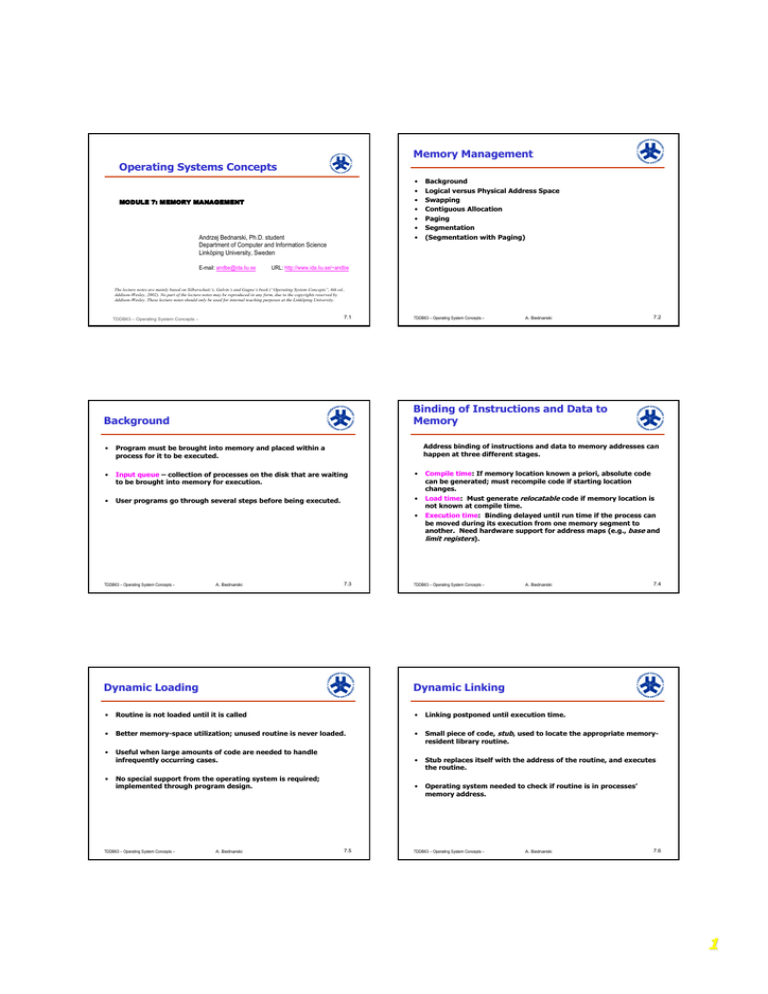
Memory Management Operating Systems Concepts • • • • • • • MODULE 7: MEMORY MANAGEMENT Andrzej Bednarski, Ph.D. student Department of Computer and Information Science Linköping University, Sweden E-mail: andbe@ida.liu.se Background Logical versus Physical Address Space Swapping Contiguous Allocation Paging Segmentation (Segmentation with Paging) URL: http://www.ida.liu.se/~andbe The lecture notes are mainly based on Silberschatz’s, Galvin’s and Gagne’s book (“Operating System Concepts”, 6th ed., Addison-Wesley, 2002). No part of the lecture notes may be reproduced in any form, due to the copyrights reserved by Addison-Wesley. These lecture notes should only be used for internal teaching purposes at the Linköping University. 7.1 TDDB63 – Operating System Concepts – TDDB63 – Operating System Concepts – 7.2 Binding of Instructions and Data to Memory Background Address binding of instructions and data to memory addresses can happen at three different stages. • Program must be brought into memory and placed within a process for it to be executed. • Input queue – collection of processes on the disk that are waiting to be brought into memory for execution. • • User programs go through several steps before being executed. • • TDDB63 – Operating System Concepts – A. Bednarski A. Bednarski 7.3 Compile time: If memory location known a priori, absolute code can be generated; must recompile code if starting location changes. Load time: Must generate relocatable code if memory location is not known at compile time. Execution time: Binding delayed until run time if the process can be moved during its execution from one memory segment to another. Need hardware support for address maps (e.g., base and limit registers). TDDB63 – Operating System Concepts – A. Bednarski 7.4 Dynamic Loading Dynamic Linking • Routine is not loaded until it is called • Linking postponed until execution time. • Better memory-space utilization; unused routine is never loaded. • Small piece of code, stub, used to locate the appropriate memoryresident library routine. • Useful when large amounts of code are needed to handle infrequently occurring cases. • Stub replaces itself with the address of the routine, and executes the routine. • No special support from the operating system is required; implemented through program design. • Operating system needed to check if routine is in processes’ memory address. TDDB63 – Operating System Concepts – A. Bednarski 7.5 TDDB63 – Operating System Concepts – A. Bednarski 7.6 1 Overlays Logical vs. Physical Address Space • Keep in memory only those instructions and data that are needed at any given time. • • Needed when process is larger than amount of memory allocated to it. The concept of a logical address space that is bound to a separate physical address space is central to proper memory management. + Logical address – generated by the CPU; also referred to as virtual address. + Physical address – address seen by the memory unit. • Implemented by user, no special support needed from operating system, programming design of overlay structure is complex. • Logical and physical addresses are the same in compile-time and load-time address-binding schemes; logical (virtual) and physical addresses differ in execution-time address-binding scheme. TDDB63 – Operating System Concepts – 7.7 A. Bednarski TDDB63 – Operating System Concepts – 7.8 A. Bednarski Memory-Management Unit (MMU) Swapping • Hardware device that maps virtual to physical address. • • In MMU scheme, the value in the relocation register is added to every address generated by a user process at the time it is sent to memory. A process can be swapped temporarily out of memory to a backing store, and then brought back into memory for continued execution. • Backing store – fast disk large enough to accommodate copies of all memory images for all users; must provide direct access to these memory images. • Roll out, roll in – swapping variant used for priority-based scheduling algorithms; lower-priority process is swapped out so higher-priority process can be loaded and executed. • Major part of swap time is transfer time; total transfer time is directly proportional to the amount of memory swapped. • The user program deals with logical addresses; it never sees the real physical addresses. TDDB63 – Operating System Concepts – A. Bednarski 7.9 Swapping (cont.) Normally, a swapped out process will be swapped back into the same memory space it occupied previously. + Reason: dictated by address binding method. Binding at load or assembly time, then processes cannot be moved! Execution time binding: processes can be moved. • Swapping is costly! + E.g., user size of a process: 1 Mbyte; Disk performance: 10 Mbyte/sec Transfer time: 1 Mbyte/10Mbyte/sec = 100 milliseconds Average latency: 6 milliseconds Seek time: often zero milliseconds Total: 2*(100+6) = 212 milliseconds. Quantum when using Round-Robin should be >> 212 milliseconds • A. Bednarski 7.10 Schematic View of Swapping • TDDB63 – Operating System Concepts – TDDB63 – Operating System Concepts – A. Bednarski 7.11 TDDB63 – Operating System Concepts – A. Bednarski 7.12 2 Contiguous Allocation: Single-Partition Allocation Contiguous Allocation • Main memory are usually separated into two partitions: + Resident operating system, usually held in low memory with interrupt vector. + User processes held in high memory. • Single-partition allocation + Relocation-register scheme used to protect user processes from each other, and from changing operating-system code and data. + Relocation register contains value of smallest physical address; limit register contains range of logical addresses – each logical address must be less than the limit register • Single-partition vs. multi-partitioned allocation + Mapping from logical addresses to physical addresses is done by MMU (Memory Management Unit) TDDB63 – Operating System Concepts – A. Bednarski 7.13 TDDB63 – Operating System Concepts – 7.14 A. Bednarski Contiguous Allocation: Multiple-Partition Allocation Contiguous Allocation: Multiple-Partition Allocation • • Partitions: + Fixed partition scheme Size of partitions are fixed 1 partition/process + Simple model – Degree of multiprogramming = number of partitions + Variable size partition scheme – Fragmentation (external) Multiple-partition allocation + Hole – block of available memory; holes of various size are scattered throughout memory. + When a process arrives, it is allocated memory from a hole large enough to accommodate it. + Operating system maintains information about: a) allocated partitions b) free partitions (holes) OS OS OS OS process 5 process 5 process 5 process 5 process 9 process 8 process 2 TDDB63 – Operating System Concepts – A. Bednarski 7.15 Contiguous Allocation: Multiple-Partition Allocation TDDB63 – Operating System Concepts – process 9 process 10 process 2 process 2 process 2 A. Bednarski 7.16 Dynamic Storage-Allocation Problem • A hole that is too big are split into two parts + Arriving process is allocated one hole + Second hole is free, i.e., still a hole. How to satisfy a request of size S from a list of free holes. • First-fit: Allocate the first hole that is big enough. • Adjacent holes are merged, forming a bigger hole • Best-fit: Allocate the smallest hole that is big enough; must search entire list, unless ordered by size. Produces the smallest leftover hole. • Worst-fit: Allocate the largest hole; must also search entire list. Produces the largest leftover hole. First-fit and best-fit are better than worst-fit in terms of speed and storage utilization. (shown by simulation studies) TDDB63 – Operating System Concepts – A. Bednarski 7.17 TDDB63 – Operating System Concepts – A. Bednarski 7.18 3 Fragmentation Fragmentation (cont.) • External fragmentation – total memory space exists to satisfy a request, but it is not contiguous. • Reduce external fragmentation by compaction + Shuffle memory contents to place all free memory together in one large block. + Compaction is possible only if relocation is dynamic, and is done at execution time. • Internal fragmentation – allocated memory may be slightly larger than requested memory; this size difference is memory internal to a partition, but not being used. TDDB63 – Operating System Concepts – 7.19 A. Bednarski Example of Compacting Hard optimization problem + I/O problem Latch job in memory while it is involved in I/O. Do I/O only into OS buffers. TDDB63 – Operating System Concepts – 7.20 A. Bednarski Example of Compacting: Solution 1 p1 p1 p1 p2 p3 pn p2 p2 p3 p3 p4 p4 TDDB63 – Operating System Concepts – 7.21 A. Bednarski Example of Compacting: Solution 2 p1 A. Bednarski 7.22 • Logical address space of a process can be noncontiguous; process is allocated physical memory whenever the latter is available. + Logical addresses are translated to physical addresses p3 p2 p3 • Divide physical memory into fixed-sized blocks called frames. + Frame size is normally power of 2, between 512 and 8192 bytes, or even 16MB. pn p4 TDDB63 – Operating System Concepts – p4 Paging p1 p2 TDDB63 – Operating System Concepts – pn p4 A. Bednarski 7.23 TDDB63 – Operating System Concepts – A. Bednarski 7.24 4 Paging (cont.) Paging (cont.) • Divide logical memory into blocks of same size called pages. + Logical memory size is denoted as 2m + Requirement: logical memory size < physical memory size + Page size is normally a power of 2, denoted 2n. • Keep track of all free frames + Frame table - maintained by OS. • To run a program of size k pages, need to find k free frames and load program. • Set up a page table to translate logical to physical addresses. + 1 page table/process (normally) • – Has internal fragmentation • + Helps removing external fragmentation • + Separates physical address space from user space [<frame id>,<free/allocated >,<process(es) id(s)>] TDDB63 – Operating System Concepts – A. Bednarski 7.25 Address Translation Scheme TDDB63 – Operating System Concepts – 7.26 A. Bednarski Address Translation Architecture • Address generated by CPU is divided into: + Page number (p) – used as an index into a page table which contains base address of each page in physical memory. + Page offset (d) – combined with base address to define the physical memory address that is sent to the MMU. Base adress TDDB63 – Operating System Concepts – A. Bednarski 7.27 Paging Example TDDB63 – Operating System Concepts – 7.28 A. Bednarski Paging Example 2^m=4 m=2 size of logical space is 2^m page size is 2^n TDDB63 – Operating System Concepts – A. Bednarski 7.29 n-m n #page offset TDDB63 – Operating System Concepts – 2^3=8 A. Bednarski 7.30 5 Implementation of Page Table Associative Register • Page table is kept in main memory. • • Page-table base register (PTBR) points to the page table. • Page-table length register (PTLR) indicates size of the page table. • In this scheme every data/instruction access requires two memory accesses. One for the page table and one for the data/instruction. • The two memory access problem can be solved by the use of a special fast-lookup hardware cache called associative registers or translation look-aside buffers (TLBs) TDDB63 – Operating System Concepts – A. Bednarski 7.31 Associative registers – parallel search + Cache memory, also called TLBs (translation look-aside buffers) Page # Frame # Address translation (A´, A´´) + If A´ is in associative register, get frame # out. + Otherwise get frame # from page table in memory (TLB miss) If so, include frame in associative register TDDB63 – Operating System Concepts – A. Bednarski 7.32 Effective Access Time Memory Protection • Associative Lookup = H time unit (e.g., H=20 nanoseconds) • Memory protection implemented by associating protection bit with each frame. • Assume memory cycle time is E time units (e.g., E=100 nanoseconds) • Valid-invalid bit attached to each entry in the page table: + “valid” indicates that the associated page is in the process’ logical address space, and is thus a legal page. + “invalid” indicates that the page is not in the process’ logical address space. • Hit ratio – percentage of times that a page number is found in the associative registers; ration related to number of associative registers. • Hit ratio = D • Effective Access Time (EAT) EAT = (E E + H) D + (2E E + H)(1 – D) = 120*0.8 + 220*0.2= 140 nanoseconds (e.g., D=80%; normally between 80-98) TDDB63 – Operating System Concepts – A. Bednarski 7.33 Two-Level Page-Table Scheme TDDB63 – Operating System Concepts – A. Bednarski 7.34 Two-Level Paging Example • • • A logical address (on 32-bit machine with 4K page size) is divided into: + a page number consisting of 20 bits. + a page offset consisting of 12 bits. Since the page table is paged, the page number is further divided into: + a 10-bit page number. + a 10-bit page offset. Thus, a logical address is as follows: page number page offset p1 p2 d 10 10 12 where p1 is an index into the outer page table, and p2 is the displacement within the page of the outer page table. TDDB63 – Operating System Concepts – A. Bednarski 7.35 TDDB63 – Operating System Concepts – A. Bednarski 7.36 6 Multilevel Paging and Performance Inverted Page Table • • One entry for each real page of memory. • Entry consists of the virtual address of the page stored in that real memory location, with information about the process that owns that page. + [ <process id>,<page number>, <offset> ] • Decreases memory needed to store each page table, but increases time needed to search the table when a page reference occurs. • Use hash table to limit the search to one — or at most a few — page-table entries. Since each level is stored as a separate table in memory, covering a logical address to a physical one may take three memory accesses. • Even though time needed for one memory access is quadrupled, caching permits performance to remain reasonable. • Cache hit rate of 98 percent yields: effective access time = 0.98 x 120 + 0.02 x 480 = 127.2 nanoseconds. which is only a 27.2 percent slowdown in memory access time. TDDB63 – Operating System Concepts – A. Bednarski 7.38 Inverted Page Table Architecture TDDB63 – Operating System Concepts – A. Bednarski A. Bednarski A. Bednarski 7.39 Shared Pages 7.40 Shared Pages Example TDDB63 – Operating System Concepts – TDDB63 – Operating System Concepts – • Shared code + One copy of read-only (reentrant or pure code) code shared among processes (i.e., text editors, compilers, window systems). + Shared code must appear in same location in the logical address space of all processes. • Private code and data + Each process keeps a separate copy of the code and data. + The pages for the private code and data can appear anywhere in the logical address space. TDDB63 – Operating System Concepts – A. Bednarski 7.41 Segmentation 7.42 • Memory-management scheme that supports user view of memory. • A program is a collection of segments. A segment is a logical unit such as: main program, procedure, function, local variables, global variables, common block, stack, symbol table, arrays TDDB63 – Operating System Concepts – A. Bednarski 7.43 7 Logical View of Segmentation Segmentation Architecture 1 • Logical address consists of a two tuple: <segment-number, offset> • Segment table – maps two-dimensional physical addresses; each table entry has: + base – contains the starting physical address where the segments reside in memory. + limit – specifies the length of the segment. • Segment-table base register (STBR ) points to the segment table’s location in memory. • Segment-table length register (STLR ) indicates number of segments used by a program; segment number s is legal if s < STLR. 4 1 2 3 2 4 3 user space TDDB63 – Operating System Concepts – physical memory space A. Bednarski 7.44 TDDB63 – Operating System Concepts – A. Bednarski 7.45 Segmentation Architecture (cont.) Segmentation Architecture (cont.) • Relocation + dynamic + by segment table • Protection. With each entry in segment table associate: + validation bit = 0 illegal segment + read/write/execute privileges • Sharing + shared segments + same segment number • Protection bits associated with segments; code sharing occurs at segment level. • • Allocation + first fit/best fit + external fragmentation Since segments vary in length, memory allocation is a dynamic storage-allocation problem. TDDB63 – Operating System Concepts – A. Bednarski 7.46 Sharing of Segments TDDB63 – Operating System Concepts – A. Bednarski 7.47 Recommended Reading and Exercises • Reading + Chapter 9 (9.6: Summary by example) • Exercises + 9.1 – 9.18 (all) TDDB63 – Operating System Concepts – A. Bednarski 7.48 TDDB63 – Operating System Concepts – A. Bednarski 7.54 8 Summary • Memory-management algorithms + Multi-programmed OS • Virtual vs. Physical addresses • Considerations (various algorithms): + Hardware support + Performance + Fragmentation + Relocation + Swapping + Sharing + Protection TDDB63 – Operating System Concepts – A. Bednarski 7.55 9
